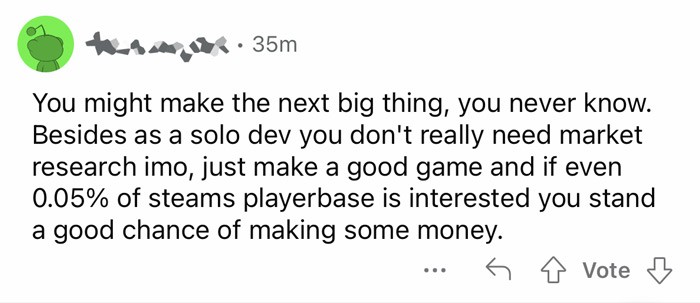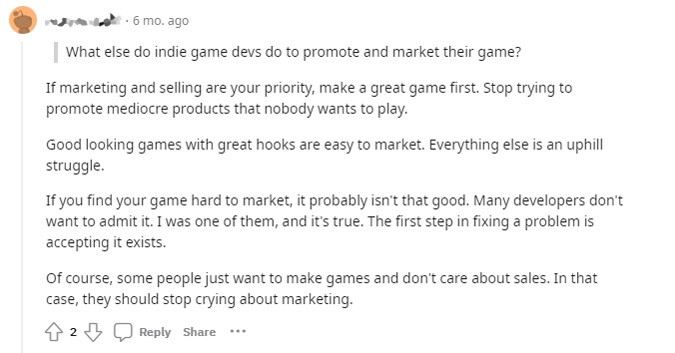Pixels & Profits
A Game Marketing Guidebook
If you’re a game developer, chances are you’ve come across marketing advice that looks something like this:





Worthless guidance, upvoted 817 times.
The guidebook you’re reading isn’t about quick fixes or “make a marketable game” platitudes. It’s about giving you the real marketing foundation you need to succeed.
Here’s what lies ahead:
Table of Contents:
Volume I
Volume II
Volume III
Volume IV
Introduction
Regardless of your game’s genre, platform, or marketplace, this guide aims to equip you with the most comprehensive understanding of game marketing available online.
Drawing on our firsthand experience with hundreds of startups here at Wabbit, we combine this with industry best practices and offer a clear path forward for your marketing journey.
I’m David, the founder of Wabbit, and I’ll be your guide.
Why this guide?
All of the marketing knowledge you currently have amounts to little more than tips and tricks held together by a wad of scotch-tape.
At the root, that problem comes from a fundamental misunderstanding of what marketing really is.
So let’s fix that real quick…
More than crafting attention-grabbing ads or trending on social media, real marketing is the craft of:
- Identifying an audience with a specific need
- Building an effective solution to that need
- Presenting it to that audience in an engaging way
The audience pays for the solution if it fits them.
They ignore you if it doesn’t.
If you’ve never thought of your game as a solution to a problem, it’s time you adopt that mindset.
In this series, I aim to provide you a comprehensive guide that combines our firsthand experience here at Wabbit, with industry best practices in game marketing — and provides a clear path forward in your marketing, regardless of your game’s genre, platform, or the marketplace you launch or promote with.
I promise you this:
There will be no hard sell, no call to subscribe to a newsletter, and no restrictions on content access.
We could have packaged this as a lead-magnet eBook or some such tactic (just like every other marketer you’ve encountered) — yes, it works, but that’s not how we roll.
I didn’t build this company to cram you into a sales funnel.
Why am I doing this?
Why would I provide a comprehensive guide that combines 20 years of first hand marketing experience with industry best practices in game marketing?
Why would I offer a clear path forward, regardless of your game’s genre, platform, or the marketplace you launch or promote with?
Why did I do the opposite of everyone else in this space?
Why is it free?
Because the “advice” you’ve received up to this point has set you up to fail, and put plainly, that pisses me off.
I built Wabbit to help early-stage entrepreneurs — which is what every aspiring indie dev is.
And I want you to succeed.
If that were the only reason, it would be enough.
But it isn’t the only reason…
I’ve worn the marketer’s hat for over two decades, but my controller has been my constant companion for twice that time.
Games have been my recreation, my education, and my safe-haven for as long as I can remember.
To me, they might just be humanity’s highest art form.
Yet, like many, I’ve grown tired of the AAA dynamic, and the same recycled money-grabs, and I long for better experiences. So, in 2022, thanks to courses from GameDev.tv, and specifically Stephen Ulibarri’s fantastic instruction in Unreal Engine, I started learning how to make them.
Then something unexpected happened…
I stumbled onto a massive gap in the game development industry: quality marketing guidance for indie studios.
All around me I see developers, hungry for knowledge, led to the slaughter by gurus shilling garbage.
So, early in 2023, I spent a few months on Reddit answering every game-related marketing question I could find, until it became clear that something more needed to happen. Because there are no quick answers to your questions, and it is inefficient to answer in the format Reddit provides.
(Also, we don’t know if Reddit will survive the current CEO.)
The Big Problem
You’ve been led to believe there’s some magic formula, some secret combination of social media posts, Steam page construction, and advertising tactics — and you think once you have that secret thing, you’ll finally get enough momentum to break through the barrier holding you back from the attention you deserve…
Like everyone else, you’ve moved down a checklist of the marketing tips you’ve pulled from the internet’s suggestions, and nothing seems to make a difference.
People tell you:
- Maybe it’s posting frequency
- Maybe it’s the trailer
- Maybe it’s the game art
- Are you on TikTok?
And all the while, the real problem sits ignored because, somehow, the assumption seems to be that game marketing is altogether different than any other form of marketing out there.
It. Is. Not.
Yes, unlike other industries, marketing in the gaming world does present some unique challenges:
- Games have relatively short product life cycles, often peaking in popularity shortly after release and then gradually losing steam.
- Gamers are a discerning audience with high expectations for quality and originality.
- The speed at which technology changes in this industry, often necessitating mid-course corrections in marketing strategies, at a breakneck pace.
Those are significant even for seasoned marketers. But if you keep reading, you’ll discover that these challenges may not actually be so unique — and the real, fundamental work of marketing might turn out to be more universal (and straightforward) than you thought.
Rather than present you with more overly-generalized tactics, this guidebook will help you deconstruct and rebuild your foundation.
Marketing’s critical first principles are largely ignored in the indie gamedev community (because nobody is teaching them to you) so, we need to start our conversation there.
It is the only way to permanently solve the problem.
If you ask most people to define marketing, you’ll get answers that talk about promoting, advertising, social, tv, and on and on — but that’s not the whole story. It isn’t even half of it.
The truth is, it is the marketers who decide what to develop in the first place!
That’s right, the very first steps of developing any product or service, starts with us marketers.
If you’re wondering how that could possibly be true, we’re going to discuss it in the next article.
Before we get to that, let me address one more thing…
With all the focus and effort it takes to actually develop your game, you might wonder why you should spend your precious time and resources on marketing?
Shouldn’t the quality of your game speak for itself?
Ideally yes, but you can’t bank on that.
“If you build it, they will come” is an outright lie.

The statement in the image above is completely wrong, and yet, look at the condescension in the post.
“Just make a great game…”
As if great games aren’t ignored (they are) every day…
In the reality of our fiercely competitive gaming market, it’s not enough to blindly create a game, even if it’s a truly great one.
If you want sales, you have to make sure your game gets the visibility it deserves.
In the chapters that follow, I’ll cover a wide range of topics, including:
- Understanding your game and its relationship to your target audience
- The power of branding and storytelling
- Traction channels
- Social media marketing
- Influencer marketing
- Community engagement
- Budgeting
- Analytics
- Pre- and post-launch marketing strategies
- and more…
This is a living guide, continually evolving to address your challenges and queries. Meaning that your feedback will directly shape this series.
Because I’m writing it for you.
By the end of our time together, you’ll be well-equipped to face the exciting challenges ahead.
So, ready your gear and prepare for the journey of a lifetime in game marketing!
Click below to continue to the next stage of our adventure, where we’ll start exploring your target audience.

